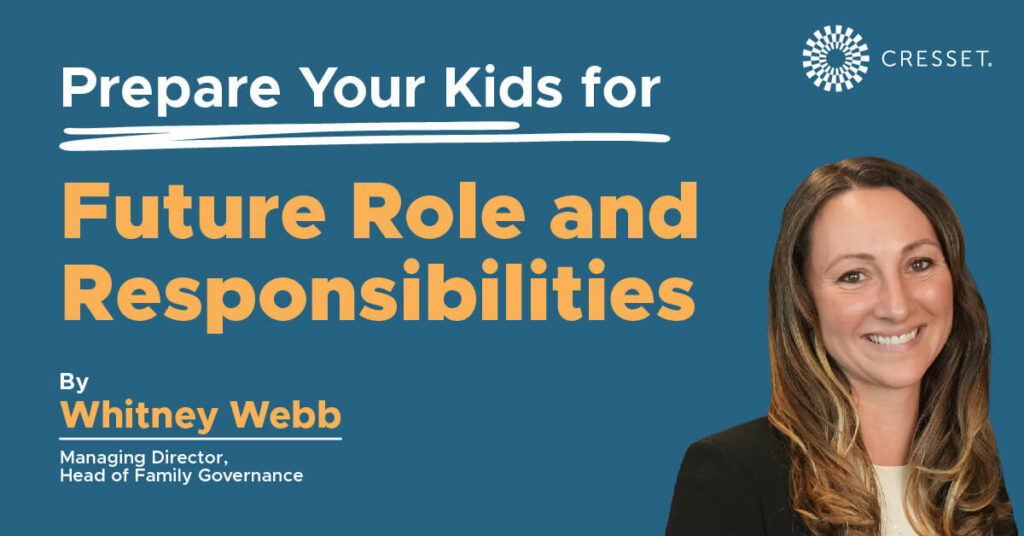
A client came to me with a dilemma. She and her husband owned several properties that they inherited from her parents, and their daughter had recently begun renting one of the units. She was continuously late on paying rent because her gig-based jobs were unpredictable, and it sometimes took an extra week to get the rent together. Should she charge her daughter the late fee like she did to other delinquent renters? Or should she cut her daughter some slack because she could? This dilemma of wearing many “hats” at once is a common one for families with significant assets and/or enterprises. This client mentioned her frustration about the complexities of serving in multiple roles, something she had to learn the hard way, and the awkward conversations she faced through the years. No one had prepared her for this balancing act, and she was determined to make the responsibilities of wealth easier on her kids than her parents had made it for her.
The key is to be clear with boundaries and expectations – which for this client could have been as simple as saying, “As your landlord, I expect rent by the first of the month.” But I also advise getting comfortable with the inevitable “grey area” of operating in multiple roles. Here are a few pieces of advice to consider:
- Make the invisible roles visible. Some roles in life are easy to identify, such as a parent, accountant, husband, or board member. However, others are not often discussed, let alone come with an instruction manual. These can include beneficiary, trustee, philanthropist, guardian, mentor, and successor. Map out the roles that all family members hold now and will hold in the future. Make it clear that while there will be many “hats” to wear, you are there to help the younger generations learn how and when to wear them. This simple conversation can help frame future roles and open the door for further conversations and support.
- Set expectations and time frames. When working with families to create boards or councils, there is often a lack of communication about the expectations of these roles. Once, when speaking with young adults who had recently joined their family’s advisory board, one sibling estimated she would need to commit 10 hours a year. Her sister estimated 15 hours a week. Include your kids in these conversations about reasonable commitments before preconceived notions have time to brew.
- Create a roadmap and introduce the experts. Once you have identified future roles and responsibilities, create a plan to help prepare your kids. Make sure to identify measurable and manageable goals, such as “Learn how to use Charity Navigator by December” or “Read the family bylaws and write down at least five questions by next June.” Begin introducing your kids to your trusted advisors and remember to consistently remind them what each person does. Families with several operating enterprises can feel overwhelming to those who are not well versed in the day-to-day operations. Be sure they feel comfortable with who to ask when questions arise.
- Set up mentorship or peer coaching when possible. For multi-generational families, setting up long-term peer mentorships can be particularly helpful for education and building connection and communication. Try to have the mentorships work both ways. For example, uncle David will be talking to his niece Melanie about his role on the family investment committee, and Melanie will be sharing her insights into regenerative farming that she learned in a summer internship. This approach helps equalize the skills people bring to the table, makes the mentorship sessions more engaging for all, and in this example could even lead to some new agricultural investment strategies for the family!
- Provide recognition opportunities when goals are met. It is important for most people to feel that they are moving forward and reaching milestones. In the absence of certificates and graduation ceremonies, try to offer new methods of recognition once milestones are met. For example, once a member of a family foundation’s junior advisory board reaches 18 years of age and has served for at least two years, that person will receive $1,000 to donate to a charity of his or her choice. Some families will move kids to the “adults table” for dinners once they give their first presentation at a family meeting. Others allow their kids to choose the location for meetings if they have attended and participated in the previous one. Whatever it is, mark the accomplishments and milestones in a way that also provides an opportunity to lead and do.
- Practice shared decision-making. It is challenging enough to make decisions with coworkers and peers. Adding in family dynamics can turn even a simple question into an all-out war. I once saw a well-intentioned family discussion about the design of a new vacation home turn into a screaming match between siblings about one’s “flashy taste” and the other’s “miserly lifestyle.” While there are many approaches and theories about decision-making, begin with empathy and remind family members of the value of a shared decision, even if it was not their first choice.
As you begin these important conversations with your family, remember that this is a marathon and not a sprint. You do not need to instill every value, intention, and lesson this week or even this year. The challenges and opportunities that come with wealth can sometimes feel overwhelming, and indeed, the strategies above can be time-consuming. Be honest with yourself about your priorities and capacity and remember that you are not alone. As with most endeavors in life, it may be wise to employ advisors, coaches, or educators to develop a plan for your family. Regardless, remember that money will inevitably play a part in shaping your life and your family’s life, so it is wise to take an active role in the design.
To explore how best to begin the “money talk” with your family, please contact Whitney Webb. View this one-pager for additional resources related to financial literacy.
About Cresset
Cresset is an independent, award-winning multi-family office and private investment firm with more than $70 billion in assets under management (as of 7/1/25). Cresset serves the unique needs of entrepreneurs, CEO founders, wealth creators, executives, and partners, as well as high-net-worth and multi-generational families. Our goal is to deliver a new paradigm for wealth management, giving you time to pursue what matters to you most.
https://cressetcapital.com/disclosures/
